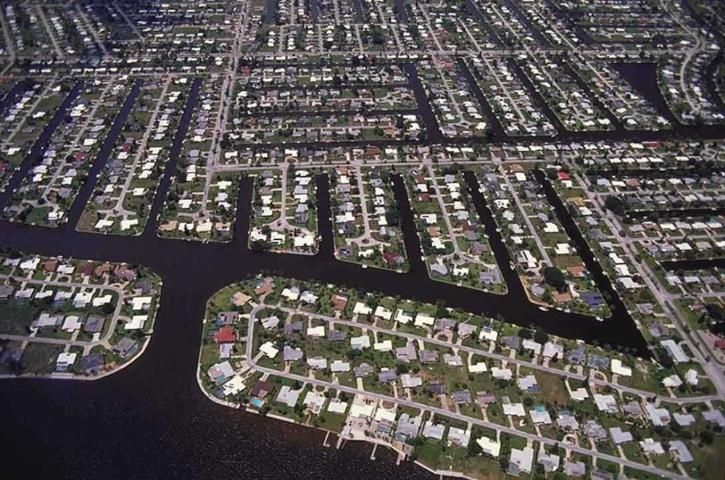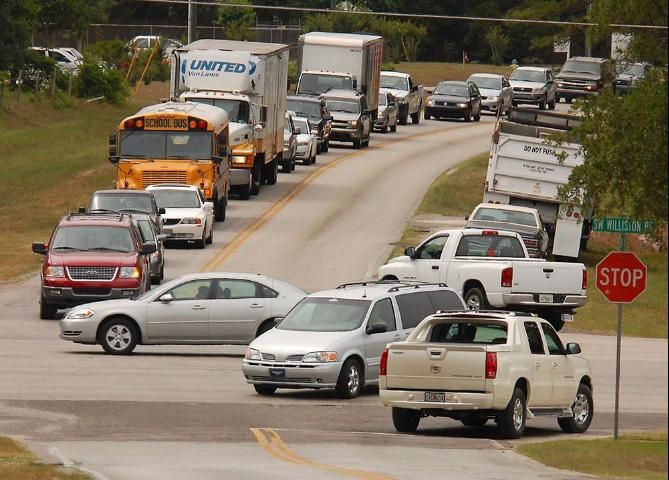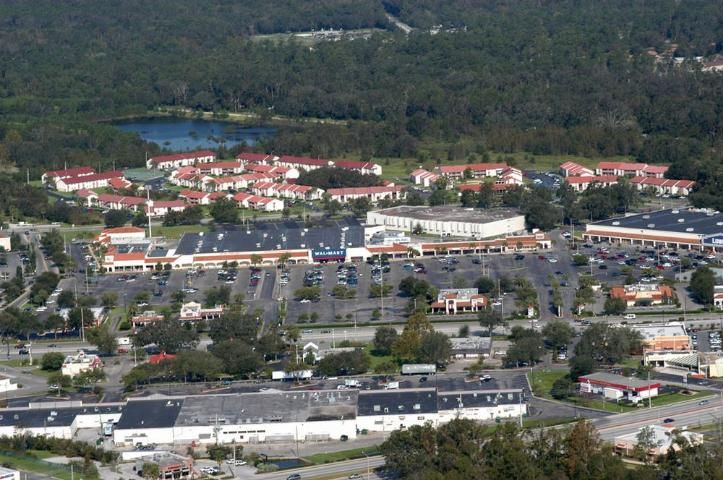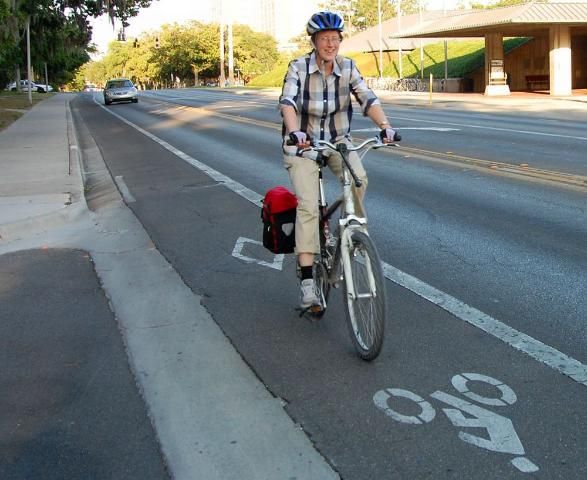The population of the state of Florida is expected to grow to over 33 million people by 2070 (Florida 2070, 2017). As urban populations grow and more people want privacy and greenspace, development inevitably creeps beyond city limits into natural and agricultural areas, creating the wildland-urban interface. The wildland-urban interface is an area of changing land uses—often an increasing amount of development leading to increasingly fragmented natural areas. Accommodating the increased population will require millions of new homes, miles of roads, and additional stores and businesses. If the development occurs without considerationfor infrastructure, commercial needs, efficient transportation options, or quality of life, it can degrade rather than enhance the nearby community. Without considering the potential consequences of new development and effectively planning to reduce negative effects, communities create urban sprawl. Urban sprawl has been defined as "low density development beyond the edge of service and employment, which separates where people live from where they shop, work, recreate and educate thus requiring cars to move between zones" (1000 Friends of Florida 2005). In this context, density refers to the number of dwellings per acre. Low-density development is often characterized by spacious, single-family houses on large lots in suburban and rural areas. High-density development tends to involve more compact dwellings, such as high-rise apartment buildings and townhouses clustered in older urban centers.
Despite the attraction and the benefits of everyone having a lawn, trees, and a big house, people are beginning to recognize the negative consequences of this land development pattern and why land-use planning is so important. There are many land-use planning tools available to help communities avoid or slow urban sprawl and develop in ways that foster economic growth, improve quality of life, and utilize natural resources wisely while protecting community heritage and character. These strategies may be used to make urban areas more appealing, thus reducing development pressures on wildlands. One such approach is called smart growth. When development does occur in the wildland-urban interface, smart growth may help make it more sustainable. This fact sheet outlines the ecological, social, and economic effects of urban sprawl and describes the guiding principles of smart growth and how it can help address these issues for residents and organizations interested in planning Florida’s future.

Credit: Larry Korhnak
Ecological Effects of Urban Sprawl
Development plans that promote sprawl have a number of consequences for local ecosystems (Luther 2005). Many of these consequences will affect any development in the wildland-urban interface.
- Destruction of wildlife habitat.
- Introduction of non-native invasive plants and animals into natural areas.
- Increased human and pet exposure to diseases such as rabies and Lyme disease.
- Increased risks of water pollution from oil and gasoline washing off paved surfaces and from pesticides, lawn fertilizers, and other chemicals.
- Increased potential for flooding and soil erosion due to impervious surfaces such as concrete or pavement.
- Decrease in groundwater for wells and irrigation caused by abundance of impervious surfaces.
- Increased risk to life and property from wildfires.

Credit: Larry Korhnak
Social and Economic Effects of Urban Sprawl
Urban sprawl can also negatively affect social and economic conditions in communities in several ways (Luther 2005).
- Increased community costs for maintaining roads, school bus routes, sewers, and other services needed when businesses and residences are spread out.
- Ongoing increases in property taxes to meet growing need for services, which may pressure rural landowners to sell to developers.
- Increased need for automobiles; increased noise, traffic, pollution; reduced potential for bicycling and walking.
- Isolation of the young, poor, and elderly who cannot drive or lack access to cars.
- Increased cost and difficulty of providing public transportation.
- Increased time needed for transportation and resultant reduction in time available to spend with family and friends or contributing to the community.
- Loss of agricultural and forestry jobs, and traditional land practices.
- Reduction of rural character or community sense of place.
- Increased ordinances that regulate logging, noise, or odors.
Research has shown that providing public infrastructure and services for sprawling, low-density subdivisions costs significantly more than providing for the same number of houses in urban areas (1000 Friends of Florida 2005). One study found that compact growth with a high-density mixture of residential and commercial development consumed 45 percent less land; and cost 25 percent less for roads, 15 percent less for utilities, 5 percent less for housing, and 2 percent less for other public expenditures than sprawling development (Burchell and Listokin 1996). In the interface, the choice is not whether or not to allow growth but rather whether to choose planned or uncontrolled growth. With population growth and interface development increasing rapidly in the South, the negative effects of urban sprawl need to be carefully considered and mitigated through effective land-use planning strategies.

Credit: Larry Korhnak
Smart Growth
Smart growth is becoming an increasingly popular approach to community development. In a national survey conducted in 2000, 78 percent of respondents favored smart growth when it was defined as "giving priority to improving services, such as schools, roads, affordable housing, and public transportation in existing communities, rather than encouraging new housing and commercial development in the countryside" (Smart Growth America 2000). Extension agents and natural resource professionals should be familiar with smart growth principles and include them in a suite of land-use tools that they can offer to citizens, decision makers, and stakeholders. Smart growth can be implemented using comprehensive planning and land-use regulations to guide, design, develop, revitalize, and build communities that
- Preserve and enhance valuable natural and cultural resources;
- Have a unique sense of community and place;
- Equitably distribute the costs and benefits of development;
- Expand choices for transportation, employment, and housing in a fiscally responsible manner;
- Value long-range, regional considerations of sustainability over short-term incremental development decisions; and
- Promote public health and healthy communities.

Credit: Larry Korhnak
Guiding Principles of Smart Growth Include:
- Recognition that all levels of government and the private sectors play an important role in creating and implementing policies that support smart growth.
Every level of government—federal, state, regional, local, neighborhood—should examine its policies and practices and replace those that have contributed to urban sprawl with those that foster smart growth.
2. Conservation and enhancement of environmental and cultural resources.
Smart growth protects the natural processes that sustain life; preserves agricultural land, wildlife habitat, natural landmarks, and cultural resources; and integrates biodiversity, ecological systems, and natural greenspace (green infrastructure) into development. These strategies are often called “nature-based solutions” because they apply principles from nature to urban landscapes, just as green roofs and stormwater ponds that act as wetlands. Smart growth promotes innovative storm-water management, maintains or enhances natural air and water quality, and fosters resource conservation. Green architecture uses design and construction practices and materials that consume fewer natural resources, use renewable resources, and improve the comfort and health of the occupants.
3. Central city vitality.
Every level of government should identify ways to reinvest in existing urban centers, re-use former commercial or industrial sites, redevelop older buildings, and bring new development to older, low-income, and disadvantaged neighborhoods. Doing so, however, often creates a challenge to protect affordable housing and historic, cultural spaces. Involving the community in making thoughtful decisions may be a valuable strategy.
4. Efficient use of land and infrastructure.
High-density development, infill development, and redevelopment of abandoned or degraded buildings result in more compact urban areas and more efficient land use. Efficient use of public and private infrastructure begins with developing neighborhoods that maximize the use of existing infrastructure. In areas of new growth, roads, schools, sewers, water lines, and other infrastructure should be planned as part of comprehensive growth and investment strategies. Regional collaboration for large infrastructure investments helps prevent inefficiency and redundancy.
5. Vital small towns and rural areas.
Urban sprawl can also occur around villages and small towns. Programs and policies need to encourage investmentto improve the economic health of small town downtowns and rural community centers. Compact development and efficient use of existing infrastructure can help rural communities get the most out of expensive basic infrastructure and services. At the same time, community members need to be informed about the benefits of a more compact design, as residents may be accustomed to spacious suburban subdivisions.
6. More housing choices and mixed-use centers accessible by multiple transportation modes.
Mixed-use developments include quality housing that is varied by type and price, and integrated with shopping, schools, community facilities, and jobs. Human-scale design and quality construction foster privacy, safety, aesthetics, and compatibility among uses and users. Land-use and transportation planning should accommodate the automobile while also providing opportunities for mass transit, bicycles, and walking.
7. A regional view of community.
Smart growth promotes balanced, integrated regional development achieved through regional planning processes.
8. Creation or preservation of a "sense of place."
Design and development can help promote a sense of place by incorporating the distinctive characteristics of a community and the particular place in which it is located. Natural features, climate, culture, geography, historical landmarks, and ecology each contribute to the unique character of a community.
9. Planning that promotes diversity, equity, and smart growth principles while encouraging participation of residents in all aspects of the planning process and at every level of government.
All planning processes, as well as the distribution of resources, must be equitable. Diverse voices must be incorporated into community planning and implementation decisions. Citizen and landowner participation ensures that planning outcomes are based on a variety of needs and objectives and result from collective decision making. This level of engagement may require providing educational programs and opportunities for community residents to learn about land-use planning. A more comprehensive approach to community engagement may be a helpful investment rather than facing conflict with each proposed development.
10. One size doesn't fit all—a wide variety of approaches can accomplish smart growth.
Every state and region is shaped by a unique blend of customs, politics, laws, natural conditions, and other factors. Each must develop its own approach to plan for growth and solve problems while encouraging meaningful involvement from public, private, and nonprofit sectors.
Summary
While increased growth may be inevitable, communities can develop in more sustainable ways by using land-use planning strategies such as smart growth. Every community has different conditions, needs, and desires, and their land-use plans should reflect these. For instance, smart growth in one community may look completely different from smart growth in another. As communities grow, citizens, planners, elected officials, and natural resource professionals can work together to determine what they want their community to become and which land use planning tools will help them achieve their goals.
References
1000 Friends of Florida. 2005. Website about 1000 Friends of Florida, https://1000fof.org/ (accessed March 2023).
Burchell, R. W.; and D. Listokin. 1995. Land, Infrastructure, Housing Costs and Fiscal Impacts Associated with Growth: The Literature on the Impacts of Sprawl vs. Managed Growth. Cambridge MA: Lincoln Institute of Land Policy.
Florida 2070: What is your vision for Florida’s Future? A special report. 1000 Friends of Florida, 2017. https://1000friendsofflorida.org/florida2070/wp-content/uploads/2017/08/FOF-1080-Newsletter-Spring-2017-v12-web.pdf (accessed March 2023).
Luther, T. 2005. "The Effects of Urban Sprawl on Forest Fragmentation and Parcelization." Private Forest. http://conserveonline.org/workspaces/privateforests/forest101/index_html/sprawl (accessed August 9, 2005).
Smart Growth America, "Americans Want Growth and Green; Demand Solutions to Traffic, Haphazard Development," news release, October 16, 2000.